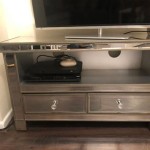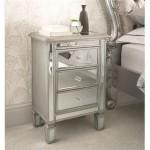```html
The Timeless Allure of White Vintage Mirrors
White vintage mirrors represent a specific category within the broader antique and vintage mirror market. These mirrors, characterized by their aged or intentionally distressed white frames, evoke a sense of history, elegance, and rustic charm. They are highly sought after by interior designers, collectors, and homeowners seeking to add character and a touch of vintage flair to their living spaces.
The appeal of white vintage mirrors lies in their versatility. They complement a wide range of interior design styles, from shabby chic and farmhouse to French country and even modern minimalist aesthetics. The white frame provides a neutral backdrop that allows the mirror's reflective surface to become the focal point, while the vintage detailing adds visual interest and depth.
The term "vintage" typically refers to items that are at least 20 years old, but not yet considered antiques (which are generally over 100 years old). However, the term is often used more loosely in the design world, encompassing items that simply possess an aged or retro aesthetic. Therefore, a "white vintage mirror" could be a genuinely old piece or a more recently manufactured mirror designed to mimic the look of a vintage original.
Key Considerations When Acquiring White Vintage Mirrors
Several factors are crucial to consider when purchasing a white vintage mirror, regardless of whether it is a genuine antique or a reproduction. These considerations include authenticity, condition, style, and size.
Authenticity: Determining the authenticity of a white vintage mirror can be challenging, particularly for those unfamiliar with antique furniture and décor. Genuine vintage mirrors often bear signs of age, such as minor imperfections in the glass (e.g., slight cloudiness or subtle distortions), wear and tear on the frame (e.g., chipped paint, scratches, or minor cracks), and evidence of previous repairs. Examining the back of the mirror and the construction of the frame can also provide clues about its age.
Reproduction vintage mirrors, on the other hand, are typically made with modern materials and manufacturing techniques. While they may be aesthetically pleasing, they lack the historical significance and unique character of a genuine vintage piece. Sellers who specialize in antique furniture are best equipped to authenticate a mirror and provide insights into its history and origin.
Condition: The condition of a white vintage mirror is a significant factor affecting its value and desirability. While some imperfections are expected in vintage items, it's important to assess the severity of any damage. Cracks in the glass, significant damage to the frame, or extensive rust can detract from the mirror's aesthetic appeal and structural integrity. Minor imperfections, such as small chips or scratches, can often be overlooked or even contribute to the mirror's vintage charm.
Before purchasing a white vintage mirror, it is essential to carefully inspect it for any signs of damage. Ask the seller for detailed photographs or, if possible, examine the mirror in person. If the mirror requires restoration, factor in the cost of repairs when considering the purchase price.
Style: White vintage mirrors are available in a wide variety of styles, reflecting different periods and design influences. Common styles include Victorian, French Provincial, Art Deco, and Mid-Century Modern. The style of the mirror should complement the overall aesthetic of the room in which it will be displayed.
Victorian mirrors, for example, are often ornate and elaborate, featuring intricate carvings and decorative details. French Provincial mirrors tend to be more rustic and charming, with a focus on natural materials and muted colors. Art Deco mirrors are characterized by their geometric shapes, bold lines, and luxurious materials. Mid-Century Modern mirrors typically have a clean, minimalist design, with a focus on functionality and simplicity.
Size: The size of the white vintage mirror should be appropriate for the space in which it will be used. A large mirror can make a small room appear larger and brighter, while a smaller mirror can serve as a decorative accent. Consider the scale of the room and the surrounding furniture when selecting the size of the mirror. A mirror that is too large or too small can look out of proportion and detract from the overall harmony of the space.
In addition, consider the height at which the mirror will be hung. A mirror should be positioned at a height that allows viewers to see their reflection comfortably. In general, the center of the mirror should be at eye level.
Different Types of White Finishes on Vintage Mirrors
The "white" finish on a vintage mirror can encompass a range of shades and textures, each contributing to a distinct aesthetic. Understanding these variations is crucial when selecting a mirror that complements a specific design scheme.
Distressed White: This finish is characterized by intentional signs of wear and tear, such as chipped paint, exposed wood, and sanded edges. Distressed white finishes are popular in farmhouse, shabby chic, and rustic interiors. They evoke a sense of age and history, creating a warm and inviting atmosphere.
Antique White: Antique white is a slightly off-white shade with warm undertones. It often has a subtle yellow or beige tint, giving it a vintage feel. Antique white finishes are commonly found on French Provincial and Victorian mirrors. They provide a soft and elegant backdrop for the mirror's reflective surface.
Chalk White: Chalk white is a matte, chalky finish that is popular for creating a rustic or vintage look. It is often used on furniture and décor items that are intended to have a handcrafted appearance. Chalk white finishes can be easily distressed or layered with other colors to create a unique and personalized effect.
Glossy White: A glossy white finish provides a sleek and modern look. While less common on genuinely vintage mirrors, it can be found on reproduction pieces or on vintage mirrors that have been refinished. Glossy white finishes are often used in contemporary and minimalist interiors.
Whitewashed: Whitewashing involves applying a thin, diluted coat of white paint to a surface, allowing the underlying wood grain to show through. Whitewashed finishes are popular for creating a light and airy feel, particularly in coastal or Scandinavian-inspired interiors. They add a touch of texture and visual interest to the mirror's frame.
Placement Strategies for White Vintage Mirrors
The placement of a white vintage mirror can significantly impact its aesthetic impact and functionality within a room. Strategic placement can enhance natural light, create the illusion of more space, and serve as a focal point.
Entryway: A white vintage mirror in the entryway can create a welcoming and stylish first impression. It provides a convenient spot for guests to check their appearance before entering or leaving the home. A larger mirror can also make a narrow entryway feel more spacious and open.
Living Room: In the living room, a white vintage mirror can be used to reflect natural light and brighten the space. It can be placed above a fireplace, behind a sofa, or on an empty wall. A carefully positioned mirror can also reflect a beautiful view or a favorite piece of artwork, enhancing the overall aesthetic of the room.
Bedroom: A white vintage mirror in the bedroom can add a touch of elegance and romance. It can be placed above a dresser, on a wall opposite a window, or as part of a gallery wall. A full-length mirror is a practical addition to any bedroom, allowing for a full view of one's outfit.
Bathroom: A white vintage mirror in the bathroom can create a spa-like atmosphere. It can be placed above a vanity, adding a touch of character and charm to the space. Ensure that the mirror is suitable for use in a humid environment, as moisture can damage the frame and glass.
Dining Room: In the dining room, a white vintage mirror can create a sense of depth and grandeur. It can be placed on a wall opposite a window, reflecting natural light and creating a more spacious feel. A mirror placed near a chandelier can also amplify the light and create a more dramatic effect.
Ultimately, the choice of where to place a white vintage mirror depends on the specific needs and preferences of the homeowner, as well as the unique characteristics of the room. Experimentation and careful consideration of the surrounding décor are key to achieving a harmonious and visually appealing result.
```
White Solid Wood Antique Rectangle Wall Mirror 30x42

Curly Obsessed With Vintage Mirrors Yummymummyclub Ca

Rustic Wooden Framed Small Wall Mirror Decor 12 X 9 Famehouse White Mirrors For Com

Vintage Antique White Wall Mirror Luxe Mirrors

Sintosin Hanging Rustic Distressed White Oval Mirrors For Wall Decor Vintage Wood Bathroom Mirror 16 9 X 1 23 6 Com

One Allium Way Antique Full Length Mirror Floor

Polyurethane Framed Antique White Oval Wall Mirror 25x33

Antique White 60 Sizes Custom Orders Mirror Farmhouse Decor Rustic Mirrors Wall Floor Framed Vintage Old Look Decorative Handmade

Sintosin Vintage Wood Framed Arendahl Mirror For Wall 24 X 36 Hanging Distressed White Rustic Arched Ornate Baroque Bathroom Mirrors Decorative Bedroom Living Room Com

Acme Furniture Dresden 46 In X 4 Modern Irregular Vintage Bone White Framed Mirror 28174 The Home Depot








